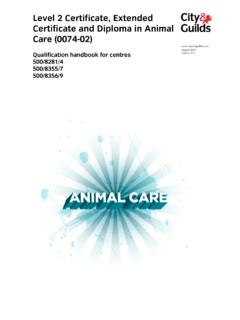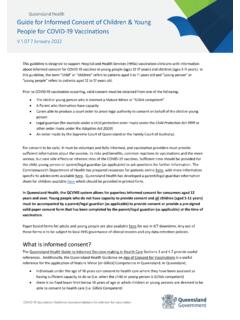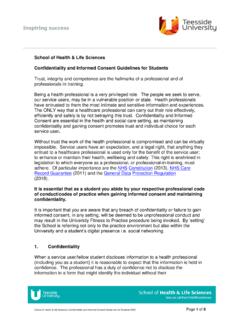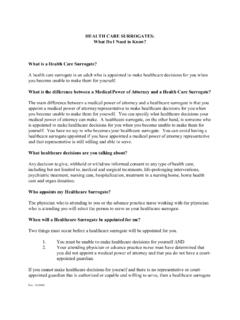Transcription of CHAPTER 15 Causes and spread of infection
1 CHAPTER 15. Causes and spread of infection Y. ou have a duty of care to protect the service users you work with, and other workers, from harm, including harm from infectious disease. To do this you need to understand the Causes of infection and how infection is spread from one person to another. Once you have a clear understanding of where infections come from and how they are spread , you can take the necessary actions to reduce the likelihood of service users you support becoming infected. Links to other units Along with other health and safety issues, the information in this CHAPTER should inform daily practice, so it links to many of the units that make up the Diploma. THE DIFFERENCES BETWEEN BACTERIA, VIRUSES, FUNGI AND PARASITES. In order to understand the Causes and spread of infection you need to understand: what is meant by the term infection '.
2 How infection is spread from person to person the means (routes) by which the body becomes infected how the body can be affected by bacteria, viruses, pathogenic fungi and infectious parasites the chain of infection . Key terms THE Causes OF infection . Microscopic means so small as to be visible only with a microscope. infection is harm caused by micro-organisms, which are often referred Pathogen is a bacterium, virus, or other to as germs'. Micro-organisms (microbes) are living organisms so micro-organism that can cause disease. small that they cannot be seen without the use of a very powerful Not all bacteria, viruses or other micro- organisms are pathogenic; they will not all microscope they are microscopic. Micro-organisms that cause cause disease in humans. infection are known as pathogens. Bacteria, viruses, pathogenic fungi and parasites are all examples of micro-organisms that can Bacteria are microscopic organisms, some types of which are pathogenic.
3 Bacteria are cause infection . made up of just one cell and are capable of reproducing themselves. Virus is a pathogenic microscopic THE DIFFERENCES BETWEEN BACTERIA, organism. Viruses cannot multiply on their VIRUSES, FUNGI AND PARASITES. own, so they have to invade a host' cell. Pathogenic fungi are yeasts and moulds The different kinds of micro-organisms have different characteristics. which can infect humans. Parasites are organisms that live on other organisms. BACTERIA. Bacteria are classi ed into different groups and can be pathogenic (capable of causing illness) or non-pathogenic (not likely to cause illness). Different types of bacteria are identi ed by their varying shapes. Bacteria are simple organisms, made up of just one cell, and are capable of reproducing by themselves. They do this through a process of growing to twice their original size and splitting into two; those two cells then split into two more, and so on.
4 This may appear to be a very simple process; however, conditions have to be right for it to happen and for the bacteria to be viable. Under the right conditions they can divide and multiply rapidly. The term used for this process is binary ssion. Bacteria exist everywhere, including inside and on our bodies. Most of them are completely harmless and some of them are very useful. For example, most strains of Escherichia coli (E. coli) are required as part of 424 THE CITY & GUILDS TEXTBOOK. 424 04/09/14 5:51 PM. Causes AND spread OF infection CHAPTER 15. the normal gut ora, as it has bene cial functions such as helping Key term with the production of vitamin K2. Bacteria in the large intestine Flora are microorganisms that normally help with the nal stages of digestion. inhabit the body without causing harm.
5 However, some bacteria are pathogenic and can cause diseases, either because they end up in the wrong place in the body, or simply because they are designed' to invade us. Some bacterial infections can make people very ill, while others have a fairly mild effect. Different streptococcal infections which are caused by strains (or varieties) of the bacterium Streptococcus can range from being mild, such as a sore throat, to life-threatening, as in necrotising fasciitis (in the latter they are often called esh-eating' bacteria). Group A Streptococcus is commonly found on the skin and inside the throat, and in many people does not cause any symptoms at all. It is important to note that bacteria may have non-pathogenic and pathogenic strains. As mentioned above, most strains of E. coli do not cause us harm, but the strain known as E.
6 Coli O157:H7 can cause food poisoning if ingested. Key terms Bacteria tend to be vulnerable to an antibiotic, which is why people Antibiotic is a substance from a micro- who have a bacterial infection are often prescribed antibiotics. It organism that is used to destroy other is important to understand that bacteria can become resistant to micro-organisms or prevent their growth. antibiotics as a result of several factors: Resistance is the ability of a micro- organism to withstand an antimicrobial Bacteria can mutate and eventually become resistant to speci c agent. antibiotics. If a person is treated with an antibiotic it is possible for that antibiotic to destroy harmless bacteria that live in and on the person, and this allows harmful bacteria to multiply and take their place. It is believed that the over-use of antibiotics in recent years has played a large part in antibiotic resistance, and the rise of what are often called superbugs', such as methicillin-resistant Staphylococcus aureus (MRSA).
7 Nowadays, doctors and GPs have to think carefully before prescribing antibiotics. Of cials at Public Health England (PHE) remind GPs that many patients do not bene t from antibiotics even if the patients themselves think that they do. Health of cials have acknowledged the pressure on GPs to prescribe, but have warned them that it adds to the cycle of antibiotic resistance. PHE and the Royal College of General Practitioners have issued guidance to help GPs explain to patients when antibiotics are not needed. The TARGET antibiotics toolkit can be seen at http://www. LEVEL 2 DIPLOMA IN HEALTH AND SOCIAL CARE 425. 425 04/09/14 5:51 PM. THE DIFFERENCES BETWEEN BACTERIA, VIRUSES, FUNGI AND PARASITES. VIRUSES. Viruses are much smaller than bacteria, and more complex. They can survive out of the body for a time.
8 Viruses are not affected by antibiotics, which is why antibiotics are not prescribed for viral infections. There are, however, antiviral drugs available to treat some infections. Viruses cannot multiply on their own, so they have to invade a host' cell and take over its machinery in order to be able to make more virus particles. They do this by latching on to human cells and getting inside them. Viruses consist of genetic materials (DNA or RNA) surrounded by a protective coat of protein. The cells of the mucous membranes, such as those lining the Key terms respiratory passages we breathe through, are particularly open to DNA (Deoxyribonucleic acid) is sometimes virus attacks because they are not covered by protective skin. As well called the blueprint of life' because it as all cold and u infections and most coughs and sore throats, viruses contains the code for building organisms.
9 Are also the cause of many serious infectious diseases. In order to get RNA (Ribonucleic acid) acts as a rid of a virus, the cell which has been invaded by the virus must be messenger of the above mentioned code killed, which results in damage to the cells themselves. For this reason when new cells are formed. doctors can only control the symptoms of a viral infection , but to date medical research has found no cures. When a virus invades the body, the immune system releases white blood cells. These cells produce antibodies, which cover the virus's protein coat and prevent it from attaching itself to the cell. White blood cells also destroy infected cells and thus kill the virus before it can reproduce. Unfortunately, some viruses such as measles, in uenza and mononucleosis (glandular fever) weaken the immune system for a period of time.
10 PATHOGENIC FUNGI. Pathogenic fungi can be either yeast or moulds, including yeasts (single-celled), and mushrooms and moulds (multi-celled). A fungus is a simple plant-like organism. Unlike plants, fungi do not make their own food. Some species of fungi get their nutrition by breaking down the remains of dead plants or animals. Others are parasites. Examples of fungal infections include athlete's foot, thrush and ringworm. Fungal infections are not often the cause of healthcare-acquired infections;. however, it is possible for an individual to acquire an infection such as ringworm in a healthcare environment. 426 THE CITY & GUILDS TEXTBOOK. 426 04/09/14 5:51 PM. Causes AND spread OF infection CHAPTER 15. PARASITES. Some parasites are very complex; many are pathogenic and cause infection and can be spread from person to person.
















